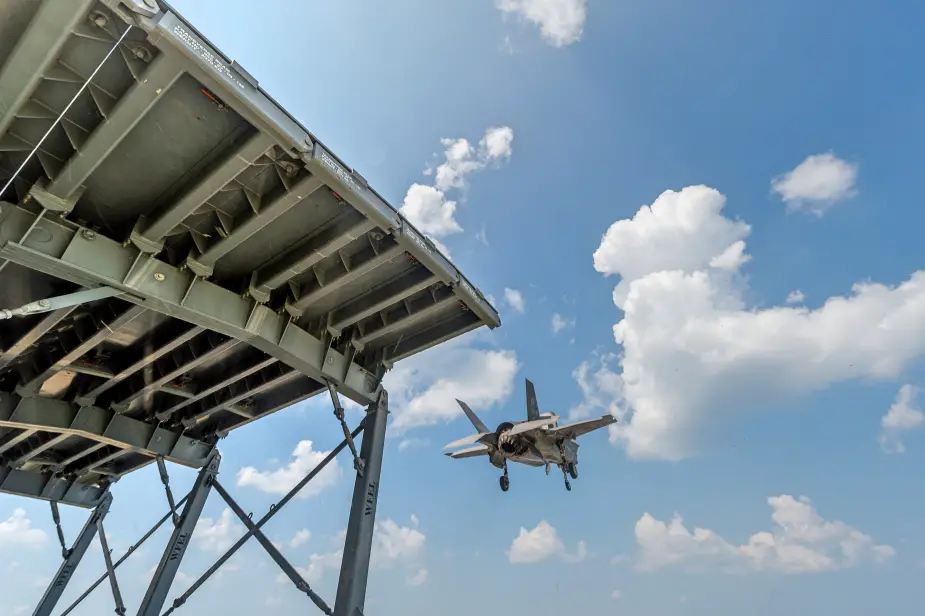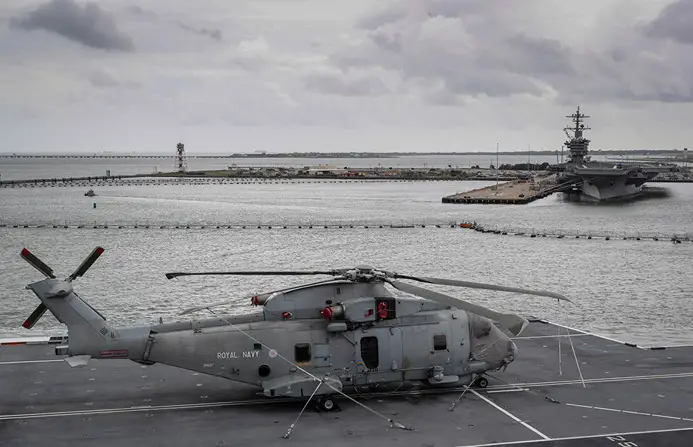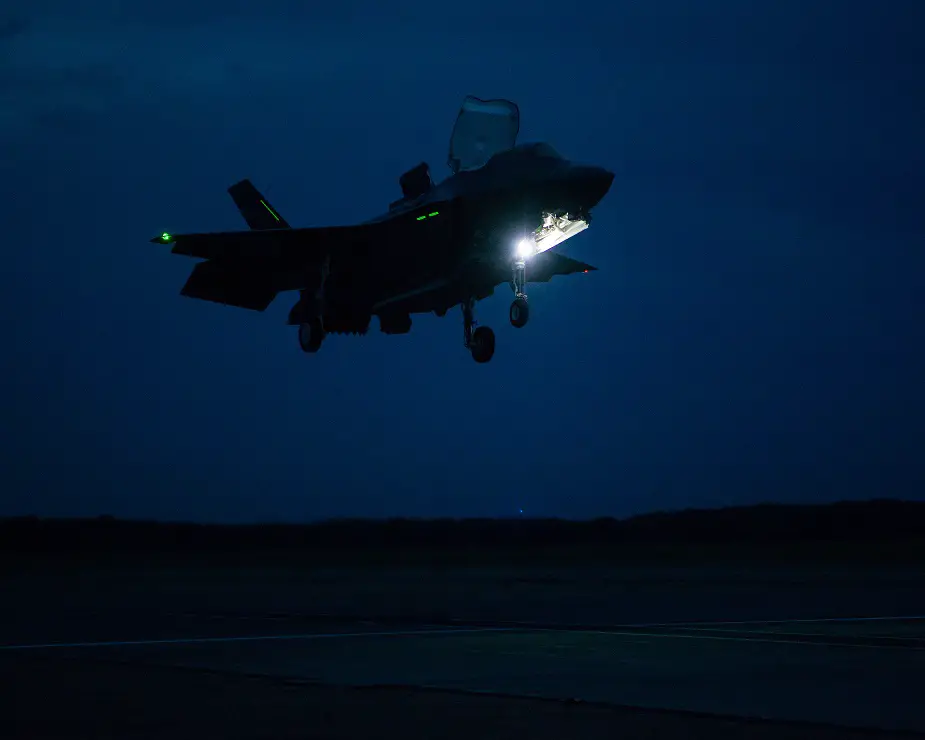Breaking news
F-35 Pax River ITF team nears historic testing with RoyalNavy's HMS Queen Elizabeth.
The F-35 Patuxent River Integrated Test Force (ITF) is nearing another milestone as they prepare to embark two F-35Bs on board the United Kingdom’s newest aircraft carrier HMS Queen Elizabeth for First of Class Flight Trials (Fixed Wing), or FOCFT (FW), this fall.
 F-35 test pilots at the Patuxent River Integrated Test Force conduct ski jumps and field carrier landing practices with F-35Bs on Aug. 28, 2018, at NAS Patuxent River as part of the workups for the First of Class Flight Trials (Fixed Wing) aboard the HMS Queen Elizabeth. U.S. Navy photo
F-35 test pilots at the Patuxent River Integrated Test Force conduct ski jumps and field carrier landing practices with F-35Bs on Aug. 28, 2018, at NAS Patuxent River as part of the workups for the First of Class Flight Trials (Fixed Wing) aboard the HMS Queen Elizabeth. U.S. Navy photo
Nearly 200 ITF personnel—active duty U.S. and U.K. military, DOD civilians as well as contractors from DOD and industry—will join the ship’s 1,500-person crew in making history when the two jets land on the British carrier. The event will be the first time an F-35 has ever landed on a foreign vessel and it helps bring an end to the eight-year hiatus since a British aircraft carrier last operated a fast jet from its deck.
“It’ll be the return of fixed-wing maritime aviation to the U.K.,” said Royal Navy Cmdr. Stephen Crockatt, U.K. team lead at the ITF. “From there on, the U.K. F-35B Lightnings can partake in supporting the defense of our realm from both land and sea, wherever the U.K. government decides.”
During two FOCFT (FW) phases, held back-to-back this fall, the team plans to perform a variety of flight maneuvers and deck operations to develop the F-35B operating envelope on Queen Elizabeth Class (QEC) carriers. They will evaluate jet performance on over 200 test points during different weather and sea conditions as well as the aircraft’s integration with the ship.
The FOCFT (FW) is the culmination of a decade of planning with individuals from U.K. and U.S. governments and industry partners in both countries.
 HMS Queen Elizabeth arrives in Norfolk, USA 17/09/2018. Royal Navy picture.
HMS Queen Elizabeth arrives in Norfolk, USA 17/09/2018. Royal Navy picture.
“It has been a genuine team endeavor from the start,” said Dave Atkinson, BAE Systems lead for FOCFT (FW), based in the U.K. “No one individual or no one organization can do everything on something of this scale. The detailed knowledge you need about the ship, the aircraft and the environment; you really must have a team ethos.”
While planning for test events typically doesn’t start that far ahead, Atkinson said all the moving parts and specific equipment needed to integrate the jet and carrier, coupled with the simultaneous design and development of the two, the lead time “had to be extensive to bring many elements together.”
As ship and jet development on both sides of the Atlantic neared completion, engineers and pilots from the Pax River ITF and BAE Systems dove deep into writing the test plan, a 300-plus page manual detailing the FOCFT (FW) execution.
In order to do so, pilots and engineers experimented with over 3,000 takeoffs and landings in BAE Systems' F-35/QEC Integration Simulator—a full motion, dome simulator—based in Warton, England, to discover “where the edges of the test envelope are,” said Royal Air Force Sq. Ldr. Andy Edgell, FOCFT (FW) lead test pilot at the Pax River ITF.
“That was where we really got the first idea of how far can we push this aircraft on [a Queen Elizabeth Class carrier] deck,” he said. “The Queen Elizabeth Class carriers are incredibly unique.”
Edgell said there are a few “British traits” built onto HMS Queen Elizabeth—notably, a ski jump ramp at the front and iconic twin islands on the flight deck separating the Bridge and Flight Control (FLYCO)—and each create variances to typical flying operations experienced on an American naval vessel.
“First drafts of the test plan were authored in early 2017, and the team spent months in 2018 further sculpting and crafting each detail to complete the document in time to start the required training flights prior to the trial,” said Timothy Marge, FOCFT (FW) lead project engineer at the Pax River ITF.
“It is a constant goal of flight testers to get a complete and thorough test plan finalized as early as practical,” Marge said. “After countless working groups, hours and hours of authoring, compiling and technical editing, two days of technical review, and four hours of executive review, our 362-page masterpiece was done."
 F-35 test pilots at the Patuxent River Integrated Test Force (ITF), conduct night field carrier landing practices Aug. 30, 2018, at NAS Patuxent River in preparation for the First of Class Flight Trials (Fixed Wing) on HMS Queen Elizabeth. U.S. Navy photo
F-35 test pilots at the Patuxent River Integrated Test Force (ITF), conduct night field carrier landing practices Aug. 30, 2018, at NAS Patuxent River in preparation for the First of Class Flight Trials (Fixed Wing) on HMS Queen Elizabeth. U.S. Navy photo
The test plan holds a couple of responsibilities, according to Marge. First, it outlines how the team will conduct safe, efficient and effective flight test aboard HMS Queen Elizabeth. Second, it details the team’s training and workup requirements that are typically conducted many weeks prior to the actual test event.
The ITF team began FOCFT (FW) workups in the summer of 2018 with additional simulator runs at the full-motion Warton facility and at the Naval Air Warfare Center Aircraft Division Manned Flight Simulator where they could add a control room with test engineers. The control room is a “huge risk mitigator” Edgell said, because it allows constant monitoring.
“They see every aspect of how the aircraft is performing and coping to different situations,” he said. “With thousands of parameters being monitored it is possible that they will identify emerging issues a long time before it becomes apparent to the pilot.”
As workups were underway, other personnel got to work ensuring the ITF team and their support equipment could integrate onto the ship; items like galley attire, flight deck clothing and hearing protection—all of which hold different requirements than that of a U.S. Navy ship—to determining how to adapt U.S. equipment to U.K. power supply and even the currency personnel need to use on board had to be addressed.
Since June, the team has focused on live flying workups refreshing their skills on day and night field carrier landing practices, ski jump takeoffs and vertical landings. The team also conducted rolling vertical landings in preparation for another unique British development.
“[Rolling vertical landings] are an important phase of the workups because another unique aspect of going to the Queen Elizabeth Class carrier is that we will be conducting experimental testing of a novel recovery landing technique—the Shipborne Rolling Vertical Landing,” Edgell said.
The Shipborne Rolling Vertical Landing (SRVL) is a British endeavor—a capability at least a decade in the making—that will allow pilots to return to ship with more stores on the aircraft after a mission, Atkinson explained.
“SRVL tests are truly experimental,” Edgell said. “It involves landing a fast jet onto an aircraft carrier with forward relative speed but without the braking assistance typically provided by an arresting gear and hook. It’s going to be a really rewarding moment for British aviation to watch that procedure actually take place.”
“This is quite a massive trial, not only for the U.K., but for the ITF,” Crockatt said.
A third FOCFT (FW) phase followed by operational testing is scheduled for 2019. Together, the tests will help the U.K. Ministry of Defence reach F-35B initial operating capability (maritime) in 2020.
As a Tier 1 partner in the F-35 program, a group of U.K. personnel have been embedded with the ITF at Pax River and Edwards Air Force Base, California, conducting flight tests since the program’s System Design and Demonstration phase. To date, the U.K. is home to nine British-owned F-35B Lightnings located at Royal Air Force Marham with the “Dambusters”, or No. 617 Squadron—the RAF’s first F-35B squadron. The RAF is scheduled to declare initial operating capability later this year. In all, the RAF and RN are programmed to purchase 138 F-35Bs over the lifetime of the program.

























